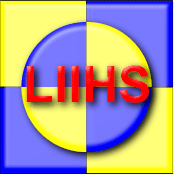
November 7-9, 2007, Toulouse, France
|
|
|
This papers presents a short description of tools presented during the demonstration session of TAMODIA on Friday November 9th 2007. Please contact the authors to get further information. List of tools:
- CoGenIVE – Code Generation for Interactive Virtual Environments
- Concours Task Tree Environmnet (CTTE)
- Development Environment for Support of Pattern-driven Model-based UI Development
- Dialog-Graph-Editor
- Diamodl editor and runtime
- e-Citiz - Web Self Service Factory
- EMODE Tool Chain
- Lotus Component Desiger with extensions for Situational Workflow Development
- MultiModal TERESA
- Task-Markov-Mapper
- The MeMo Workbench – Early model-based usability evaluation of interface designs
CoGenIVE – Code Generation for Interactive Virtual Environments
Authors: Lode Vanacken, Tom De Weyer, Tim Tutenel, Erwin Cuppens, Joan De Boeck, Chris Raymaekers, Karin Coninx (EDM, Hasselt, Belgium)
E-mail: lode.vanacken@uhasselt.be - Web page: http://edm.uhasselt.be/vr-demo/nimmit.html
Abstract:
CoGenIVE is a tool developed within the VR-DeMo project (Virtual Reality: Conceptual Descriptions and Models for the Realization of Virtual Environments). The VR-DeMo project aims to ease the development process of VE applications by defining applications on a higher level. These high-level models have the advantage to provide a basis for discussing the development of the VE application. Furthermore, by automatically translating some models into source code and interpreting other models at run time, the development time can be minimised. This also allows the designer of the virtual environment to flexibly change properties of the application.
CoGenIVE not only allows the designer to define the different models, but also allows to make connections between these models. First, the designer can define the task model using a ConcurTaskTree (CTT). From this CTT model, a dialog model is generated. This dialog model indicates when the different tasks can be executed. Next, the designer must indicate when the different menus and dialogs must be shown by linking them to the different “states” in the dialog model. These menus and dialogs are created using a description language called VRIXML. Furthermore, the designer can design or prototype interaction using NiMMiT (Notation for MultiModal Interaction Techniques) diagrams. When the designer has finished modelling the interaction, CoGenIVE generates the necessary XML files in order to represent the NiMMiT diagrams and the VRIXML elements. The CoGenIVE tool also generates the VE application using VRment, our Virtual Environment framework, and a number of code templates. The application developers only need to code the specific functionality in a number of predefined places and to compile this code. If certain code files need to be regenerated because the designer has added or changed the functionality, the manual changes are automatically taken into account by the CoGenIVE tool.
Screenshots:
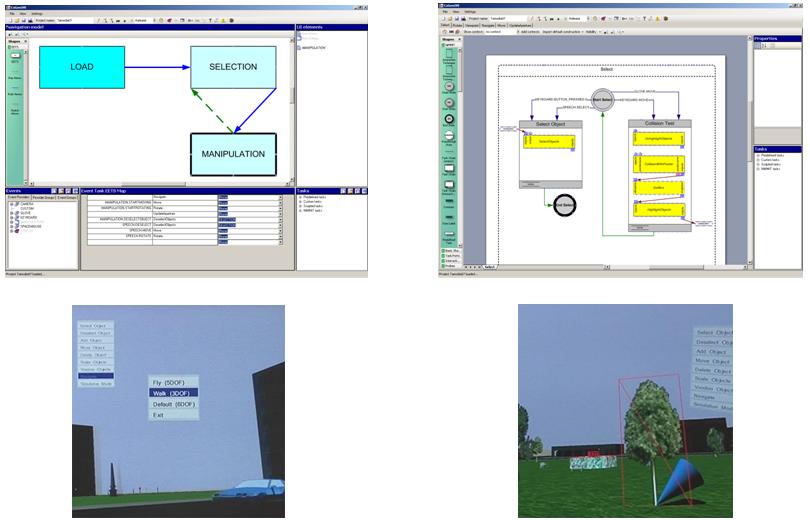
Concours Task Tree Environmnet (CTTE)
Authors: Giulio Mori, Fabio Paternò, Carmen Santoro (ISTI-CNR, Pisa, Italy)
E-mail: fabio.paterno@isti.cnr.it - Web page: http://giove.isti.cnr.it/ctte.html
Abstract:
The Concurrent Task Tree Environment (CTTE) is a Java-based tool realised by the HIIS Lab at ISTI/CNR in Pisa (Italy), allowing the user to build CTT task models, also providing thorough support for analyzing and simulating them. Using the tool it is posible to specify task models for both single user and cooperative applications, which can then be used to improve the design and evaluation of related interactive software applications.
Screenshots:
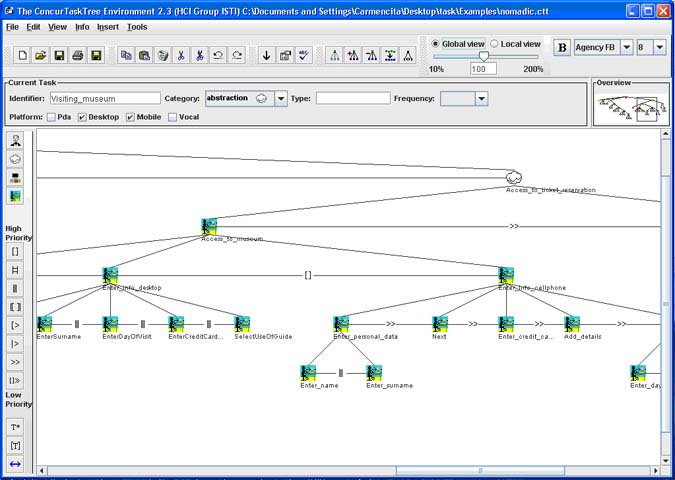
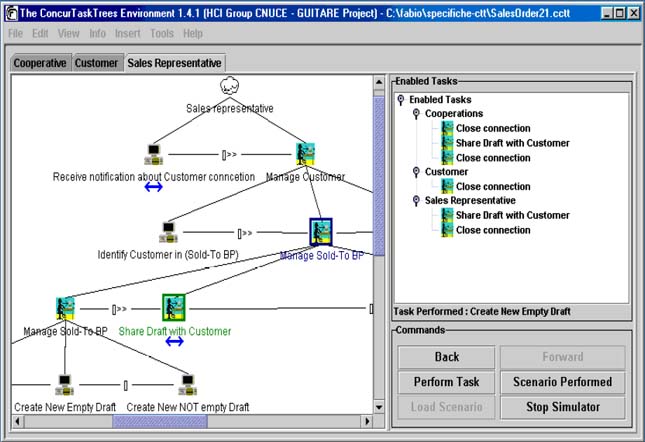
Related publications:
CTTE: Support for Developing and Analyzing Task Models for Interactive System Design, Mori G., Paternò F., Santoro C., IEEE Transactions on Software Engineering (August 2002, pp.797-813).
ConcurTaskTrees: An Engineered Notation for Task Models. F.Paternò, Chapter 24, in Diaper, D., Stanton, N. (Eds.), The Handbook of Task Analysis for Human-Computer Interaction, pp.483-503, Lawrence Erlbaum Associates, Mahwah, 2003
CTTE: An Environment for Analysis and Development of Task Models of Cooperative Applications. F.Paternò, G.Mori, R.Galimberti, Proceedings ACM CHI'01, ACM Press, Seattle, 2001.
Model-based Design and Evaluation of Interactive Applications. F.Paternò, Springer Verlag, November 1999, ISBN 1-85233-155-0.
Development Environment for Support of Pattern-driven Model-based UI Development
Authors: Frank Radeke, Peter Forbrig (European Business School and University of Rostock, Germany)
E-mail: frank.radeke@ebs.edu
Abstract:
This tool provides a development environment for supporting pattern-driven model-based UI development. For this purpose it contains modules for model-based design and modules for pattern-driven design, which are closely integrated. The model-based design module allows creating, refining and linking of task, dialog, abstract and concrete UI models. The pattern-driven design module allows applying patterns to the models in order to reuse predefined solutions captured by the patterns. In general, the pattern application process contains three basic steps: Pattern selection, pattern instantiation and pattern instance integration, which are supported by the tool.
For the pattern selection the developer can browse the pattern repository, consult information provided for the patterns and finally select an appropriate pattern. The pattern instantiation is supported by a wizard which guides the developer through the process of creating an instance of the pattern. Finally an integration wizard supports the developer in integrating the created pattern instance in a target model.
In order to achieve close integration of pattern-driven design and model-based design modules, the development environment is based on the Eclipse platform. The single modules are provided as plug-ins. An XML-format (USIPXML – User Interface Pattern Extensible Markup Language) is used to describe the patterns in a machine-readable, but generic way.
Screenshots:

Related publications:
Radeke, F.; Forbrig P. (2007). Patterns in Task-based Modeling of User Interfaces. In proceedings of TAMODIA 2007, 7th – 9th Nov. 2007, Toulouse, France.
Radeke, F. (2007). Pattern-driven Model-based User Interface Development. Diploma Thesis in the Department of Computer Science, Rostock University.
Dialog-Graph-Editor
Authors: Daniel Reichart
E-mail: daniel.reichart@uni-rostock.de
Abstract:
The tool provides an integrated development environment for user interfaces. In particular it allows for the creation and subsequent refinement of major UI models such as the task, dialog, and presentation model. Task models are defined using an extended form of the Concurrent Task Trees (CTT) language, which has been enriched with additional operators, such as Instance Iteration (#). Next, taking the task specification as a starting point, the tool assists the designer in the creation of a dialog graph, whose nodes represent dialog views (e.g. a window, or a panel) and whose edges denote transitions from one dialog view to another. Furthermore, UI widgets (e.g. buttons, textfields, choice boxes, etc.) are associated to the various tasks resulting in the presentation model.
In order to accelerate development and to maximize reuse the tool interactively supports the application of patterns. In particular it assists the developer in the selection, instantiation and integration of suitable patterns. Once the task, dialog, and presentation model have been created, an interactive prototype of the envisioned UI can be automatically generated. At this step, the designer is given the choice to choose between various target platforms.
The presented tool is implemented as an Eclipse-plugin using the Eclipse Modeling Framework.
Screenshots:
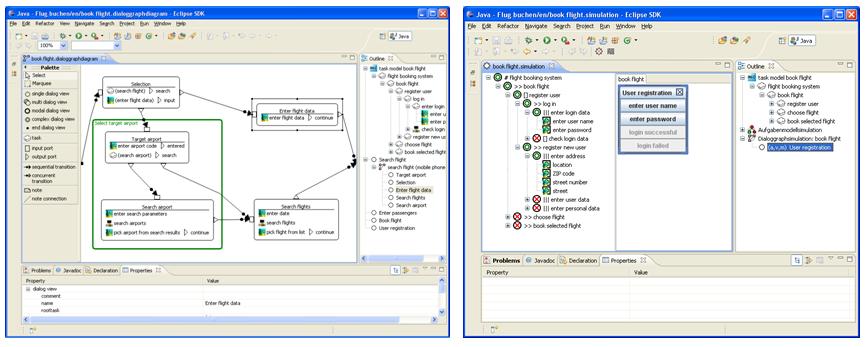
Related publications:
Forbrig P.; Reichart, D. (2007). Ein Werkzeug zur Spezifikation von Dialoggraphen. Mensch und Computer 2007, Weimar, Germany.
Diamodl editor and runtime
Authors: Hallvard Traetteberg (Dept. Computer and Info. Sciences, NTNU, Norway)
E-mail: hal@idi.ntnu.no - Web page: http://www.idi.ntnu.no/~hal/research/diamodl
Abstract:
Diamodl is an executable dialog modelling language, based on an input/output-abstraction of user interface components, dataflow and statecharts. The Eclipse-based (GMF) graphical editor provides support for creating and manipulation Diamodl diagrams with direct manipulation tools. The Diamodl runtime executes Diamodl models to allow rapid prototyping. It utilises Eclipse’s SWT toolkit for the GUI, Eclipse’s modelling and data binding framework for data handling and flow, Apache’s SCXML Statecharts engine for activation logic and GNU’s Rhino Javascript engine for scripting.
Screenshots:
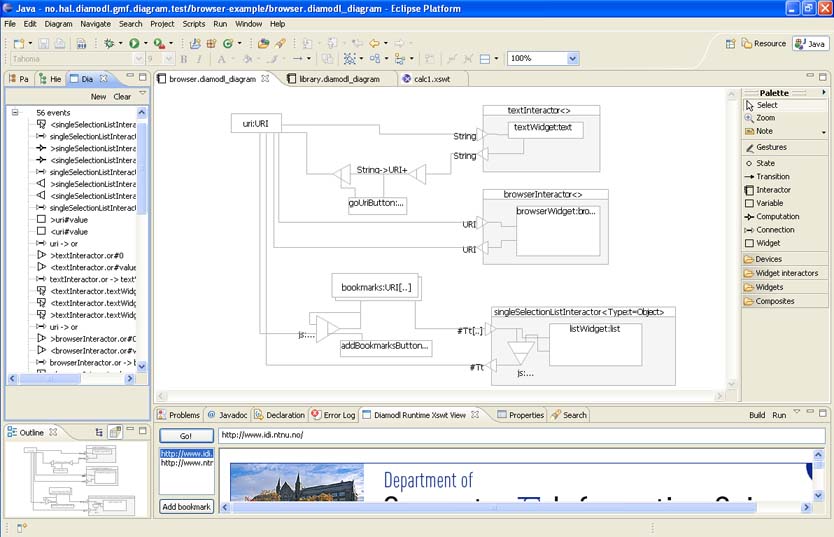
e-Citiz - Web Self Service Factory
Authors: Génigraph (Toulouse, France)
E-mail: info@e-citiz.com - Web page: http://www.e-citiz.com
Abstract:
e-Citiz is the Web Self-Services Factory, an MDA (Model Driven Architecture) platform allowing extremely rapid development and deployment of transactional Web Self-Services. e-Citiz provides business analysts a modeler and a production platform for delivering transactional Web applications. Developing transactional Web applications without programming helps business analysts respond swiftly to market expectations. Also, e-Citiz provides a native compliance with Accessibility standards (W3C WAI AA).
Development and deployment of a customer eligibility server for an ISP: reduced from two months to one week. Development and deployment of a student grant registration application: reduced from one year to three months.
Screenshots:
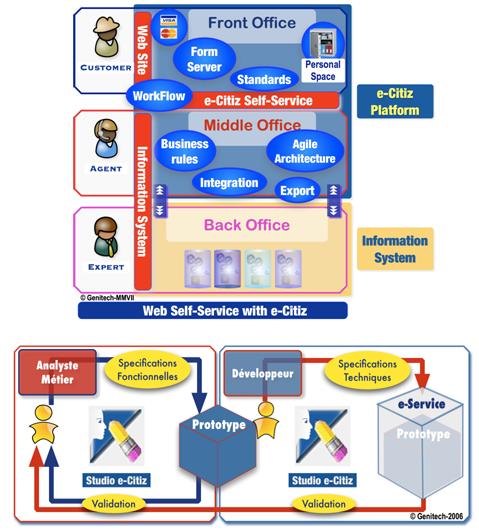
Related publications:
Xiong, Joseph; Farenc, Christelle; Winckler, Marco. Analyzing Tool Support for Inspecting Accessibility Guidelines during the Development Process of Web Sites, In Proceedings of the 1st International Workshop on Web Usability and Accessibility, IWWUA 2007, Nancy, France, December 3-7, 2007.
Xiong, Joseph; Diouf, Mouhamed; Farenc, Christelle; Winckler, Marco. Automating Guidelines Inspection: From Web Site Specification to Deployment. In Proceedings of the 6th International Conference on Computer-Aided Design of User Interfaces (CADUI), Bucharest, Romania, June 5-8, 2006.
Standard Business Rules Language: Why and How? (/Mouhamed Diouf, Kaninda Musumbu, Sofian Maabout/) ICAI2006 26-29 juin 2006, (Las Vegas, US)
Adding semantics to models for automatic business rules generation (Mouhamed Diouf, Kaninda Musumbu, Sofian Maabout) IESM2007, 30 Mai - 2 Juin 2007 (Beijin, Chine)
Merging Model Driven Architecture and Semantic Web for business rules generation (Mouhamed Diouf, Sofian Maabout and Kaninda Musumbu) RR2007 7-8 Juin 2006 (Innaburk, Autriche)
Merging and aligning business rules sets using Semantic Web technics (Mouhamed Diouf, Sofian Maabout and Kaninda Musumbu) SWWS2007, 25-28 Juin 2007 (Las Vegas, US)
Semantics enrichment in Model Driven Architecture: automatic business rules generation (Mouhamed Diouf, Sofian Maabout and Kaninda Musumbu) EEE2007, 25-28 Juin 2007 (Las Vegas, US)
GENERATING AND MERGING BUSINESS RULES by weaving MDA and Semantic Web (Mouhamed Diouf, Sofian Maabout and Kaninda Musumbu) MDEIS2007, 12-13 Juin 2007 (Funchal, Madeira, Portugal)
EMODE Tool Chain
Authors: Mathias Heinrich et al. (SAP Research, Dresden, Germany)
E-mail: matthias.heinrich@sap.com - Web page:
Abstract:
I’ll divide the upcoming demo session in two major blocks. At first I’ll present a screen cast showing the required steps to create a “Hello World Example” using the EMODE tool chain. Secondly I’ll take a more complex application (the Flight Booking Example) and will modify the application live on stage.
Screenshots:
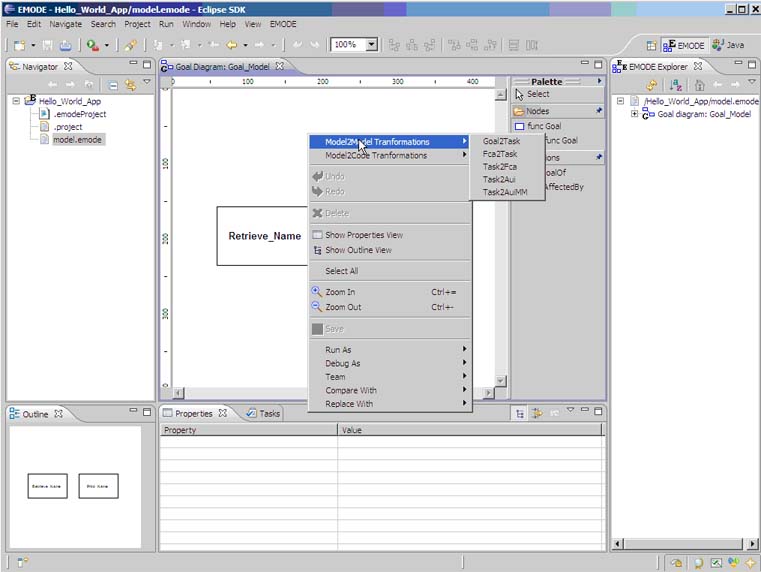
Lotus Component Desiger with extensions for Situational Workflow Development
Authors: Markus Stolze, Phil Riand, Mark Wallace, Terry Heath (IBM Research, US)
E-mail: mgstolze@us.ibm.com
Abstract:
Lotus Component Designer (LCD) is a software development tool built on the Eclipse 3.2 platform. It helps small to medium businesses quickly develop line-of-business applications for WebSphere Portal Express V6 without writing code. Developers can create situational applications that serve short-term business needs, or extend existing applications with collaborative components.
LCD provides a number of ready-made standard template applications. These make it easy to create applications such as Blogs, Contact Lists, and Discussion Databases. However, there is currently no standard template for creating simple workflow applications. This is because workflow applications tend to be quite different from each other. One workflow application might support a hiring process where job descriptions are published and job applications are tracked by managers and directors. A different workflow application might support tracking of contract proposals that are worked on by client representatives, domain experts, product managers and pricing experts. These workflow applications are quite different. They work with different data entities, the pages require different page layouts for the data display and operations, and the logic for the pages is different. Currently, development of such workflow applications in LCD has to start with a “blank” standard template where each workflow application is created from scratch.
In this demo we introduce an LCD template application for workflow. Contrary to the standard template applications, it is not meant to provide a ready-made application. Instead, it provides adaptable base components and functions that support the rapid development of situational workflow applications.
Related publications:
Agile Development of Workflow Applications with Interpreted Task Models. Markus Stolze, Philippe Riand, Mark Wallace and Terry Heath. TAMODIA 07, Toulouse, France 7-9 November 2007. Springer.
Lotus Technical White Paper. Developing Situational Workflow Applications with Lotus Component Designer. Markus Stolze, Philippe Riand, Mark Wallace and Terry Heath. Available at: http://www-1.ibm.com/support/docview.wss?uid=swg27010668&aid=1
MultiModal TERESA
Authors: Giulio Mori, Fabio Paternò, Carmen Santoro (ISTI-CNR, Pisa, Italy)
E-mail: fabio.paterno@isti.cnr.it - Web page: http://giove.isti.cnr.it/teresa.html
Abstract:
MULTIMODAL TERESA is a transformation-based environment, supporting multimodal interfaces designed and developed at the HIIS Lab of ISTI-C.N.R. in Pisa (ITALY). It is intended to provide a complete semi-automatic environment supporting a number of transformations useful for designers to build and analyse their design at different abstraction levels and consequently generate the user interface for a specific type of platform. The tool currently supports the design and development of user interfaces for a number of different platforms and modalities (graphical + vocal desktops, PDAs, mobile phones, vocal systems, digital TVs, ..)
Screenshots:
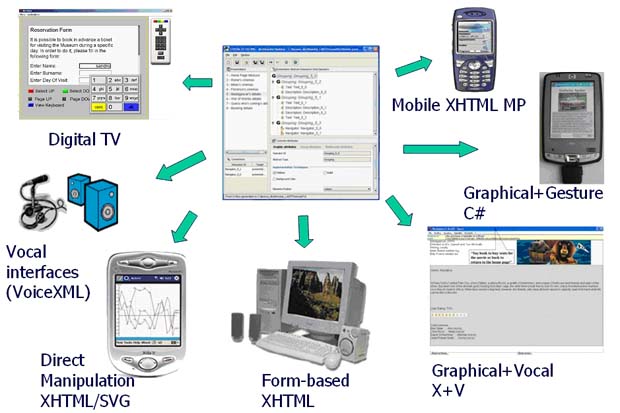
Related publications:
Authoring Interfaces with Combined Use of Graphics and Voice for both Stationary and Mobile Devices. F.Paternò, F.Giammarino, Proceedings AVI’06, Venice, ACM Press, May 2006.
Development of MultiModal Interfaces in Multi-Device Environments. S.Berti, F.Paternò, Proceedings INTERACT ’05, Roma, September 2005, Lecture Notes Computer Science 3585, pp. 1067-1070, Springer Verlag.
Design and Development of Multi-Device User Interfaces through Multiple Logical Descriptions. G. Mori, F. Paternò, C. Santoro, IEEE Transactions on Software Engineering, August 2004, Vol.30, N.8, pp.507-520, IEEE Press.
A Unified Method for Designing Interactive Systems Adaptable to Mobile and Stationary Platforms. F.Paternò, C.Santoro, , Interacting with Computers, Vol.15, N.3, pp 347-364, Elsevier, 2003.
Tool Support for Designing Nomadic Applications. G. Mori, F. Paternò, C. Santoro, Proceedings ACM IUI’03, Miami, pp.141-148, ACM Press.
One Model, Many Interfaces. Paternò, F., Santoro, C., Proceedings of CADUI 2002, the 4th International Conference on Computer-Aided Design of User Interfaces, Ch. Kolski & J. Vanderdonckt (eds.), Kluwer Academics Publisher, Dordrecht, 2002, pp 143-154,Valenciennes (France), 15-17 May 2002.
Task-Markov-Mapper
Authors: Maik Wurdel, Peter Forbrig (University of Rostock, Germany)
E-mail: maik.wurdel@uni-rostock.de
Abstract:
The tool facilitates the creation of Markov Models from a given task specification. Markov models are used predominantly in the domain of ambient intelligence where they tackle the problem of intention recognition based on observations such as sensor data or localizations information. As such they play an important role in implementing proactive assistance of Smart Environment applications. The transformation is defined based on formal meta-models which have been created for both, an extended form of CTT task models and Markov models.
The design of the tool is based on a generic framework for specifying domain specific extensions for task models. In particular a predefined generic task model can be adapted to a specialized task model, which suits the specific needs that are inherent with the problem domain. Moreover, the framework offers the opportunity to define generic transformations applicable for all specific task models that has been derived from the generic base task model. This was possible by using the paradigm of model-driven development together with the EMF, GEF and GMF frameworks of the Eclipse platform.
In the example provided with the tool, we modeled the overall intention of the group (over time) during a group meeting.
Screenshots:
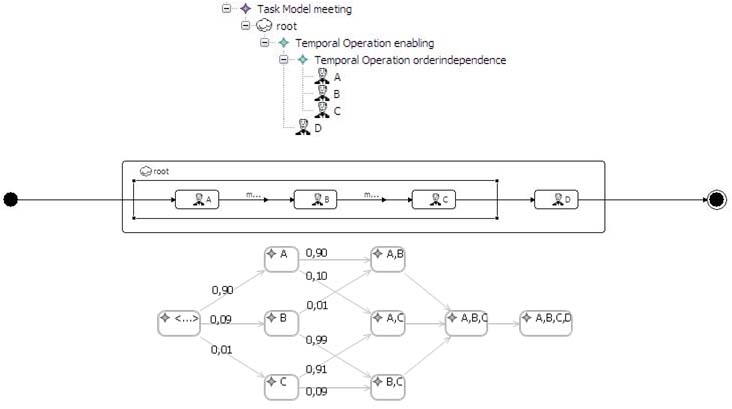
Related publications:
Wurdel, M.; Burghradt, C.; Forbrig, P.(2007). Supporting Ambient Environments by Extended Task Models. In proceedings of AmI 2007, 7th – 10th Nov. 2007, Darmstadt, Germany.
The MeMo Workbench – Early model-based usability evaluation of interface designs
Authors: Anthony Jameson, Angela Mahr, Michael Kruppa, Andreas Rieger, Robert Schleicher (DAI-Labor, TU Berlin, Germany)
E-mail: kruppa@dfki.de - Web page: http://www.dai-labor.de/index.php?id=1000&L=1
Abstract:
Modern technical systems like spoken dialogue systems or e-business web applications and their interaction capabilities with users tend to be quite complex. Consequently, usability is a key issue for the acceptance and success. Today we have one-shot usability testing with real users or own employees for a few selected products. This can take place only at the end of a product’s development cycle, is time consuming, and requires enormous human effort.
The MeMo Workbench aims at the realization of a semi-automatic usability evaluation tool. Significant improvements of usability evaluation, reduction of test cycle duration and time-to-market can be reached in this way. The key idea behind MeMo is to use mental models for an explicit description of task and interaction models of systems and users.
We will present the current implementation of the MeMo Workbench which realizes the key features as described above. To illustrate the flexibility of the workbench, we will present two different, exemplary applications (a part of a real life e-shop and a spoken dialog system allowing to control home appliances) which have been modeled and evaluated with the help of the MeMo Workbench.
Screenshots:
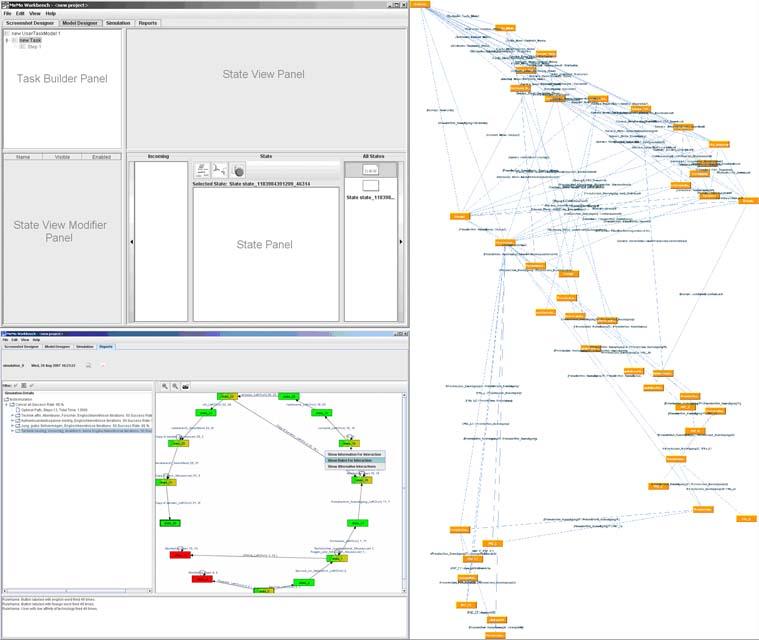
Last update:





